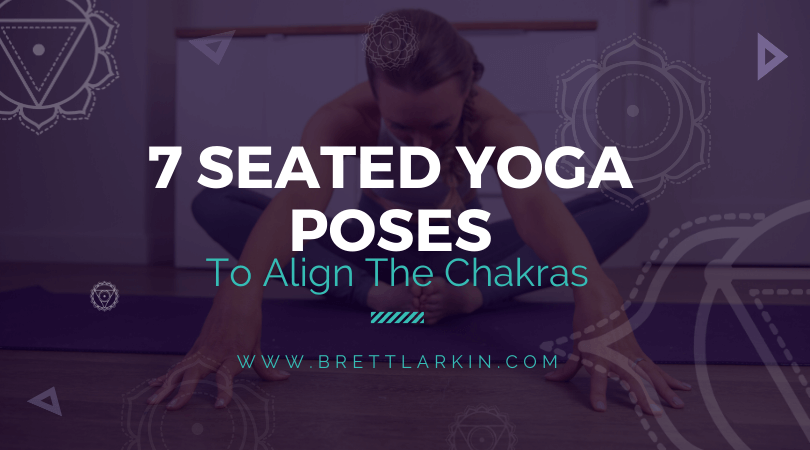
There are so many different types of yoga poses, many of them promised to strengthen and tone your body.
Of course, this is true. A diligent yoga practice will likely result in a fit body.
But yoga has countless benefits, from making us more flexible and stronger to helping us combat anxiety and stress.
The main purpose of yoga, though, is its spiritual aspect, which allows us to become more aware of our bodies and our true selves so that we can live to our highest potential. That, among many other things, includes working on our chakras.
A traditional yoga practice uses yoga postures to guide energy through the chakras. In this way, each yoga pose is often held for a long time, sometimes up to hours.
Don’t worry, I don’t expect you to hold any of these yoga postures for hours!
Instead, move through each posture individually, holding the yoga asana for as long as is comfortable.
I’ve gathered seven seated yoga poses that you can do right now at home (and even hold for a long time). Each seated position is associated with one of the seven chakras and will allow you to align all chakras in your body while also stretching your muscles to release any built-up tension.
Best of all, these are all seated poses, so you can hold them for longer, getting a good stretch and relieving stiff or painful joints too!
1. Crown Chakra – Rabbit Pose
The most beneficial pose for balancing the Crown Chakra is the headstand, which is an advanced yoga pose that not everyone can do. The Rabbit pose is a safer and gentler alternative.
When done well, this pose becomes an ideal way to stimulate your Crown Chakra. Since this is a deep forward bending pose, it also lengthens your spine and releases tension from the lower back and the neck. That makes it a good choice for anyone who spends a lot of time sitting at the desk. It also requires core strength in the abdominal muscles and can help you become more aware of your breath.
How to do the Rabbit pose:
- Start in a kneeling pose, with your knees hip-width distance apart and your toes tucked
- Contract your core to lift the hips away from your heels
- Hold the back of your feet with your hands
- Roll your shoulders back and move the top of your head toward the floor, gently resting your forehead on your yoga mat
- If your head doesn’t touch the floor, don’t force it – just put a block underneath
Hold the pose for 5 to 10 breaths and notice how the back and sides of your body expand with every inhale and then retract on the exhale. If you’d like, you can hold this seated posture for even longer.
2. Third Eye Chakra – Child’s Pose
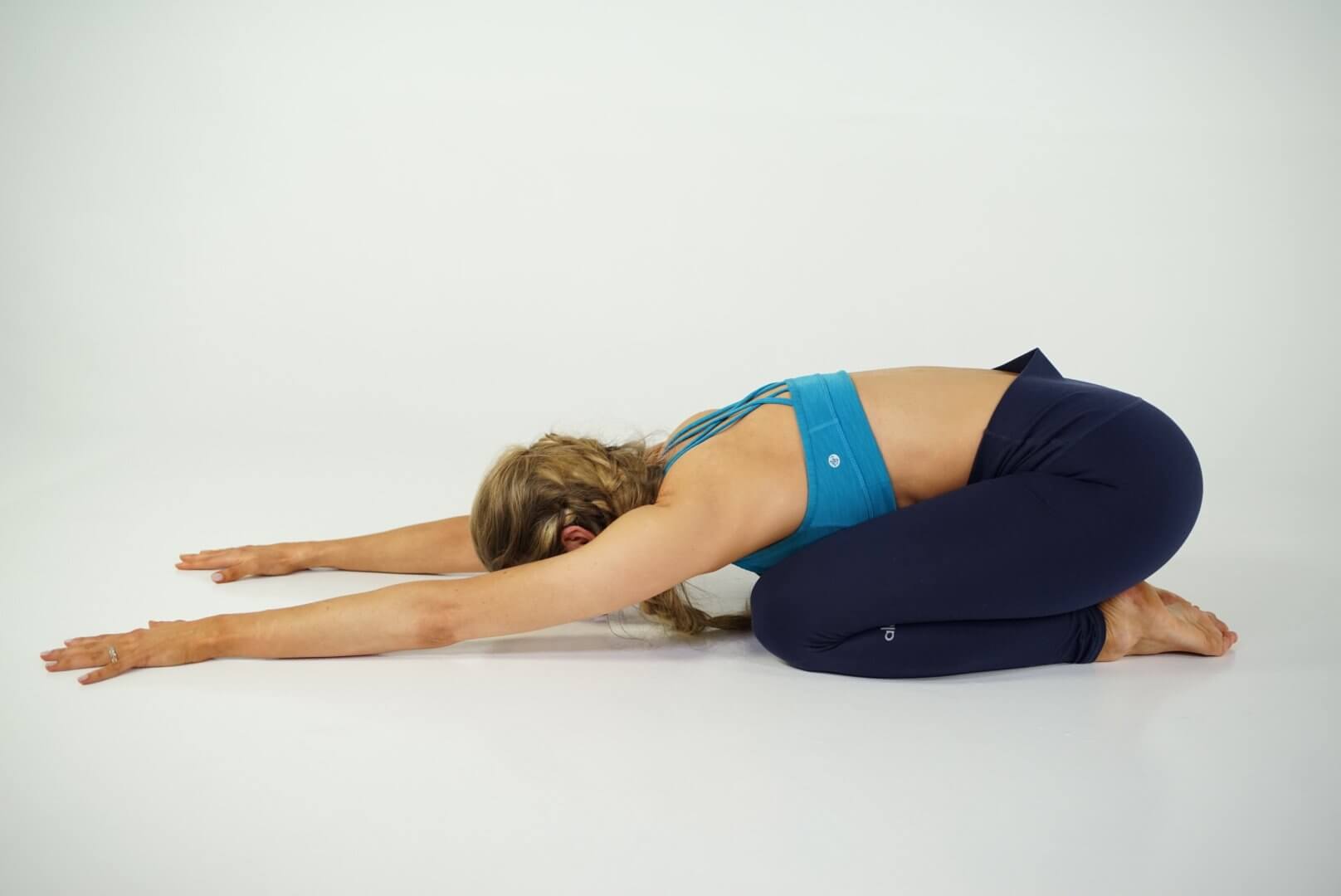
Child’s pose is a comforting asana that is often used as rest in between more challenging postures. However, it is powerful on its own, both in a physical and spiritual sense. This seated forward bend stimulates the Third Eye Chakra as it grounds the energy from your third eye point to the floor and allows you to focus inward.
It is a good seated posture to get in anytime you feel stressed or anxious. It is also beneficial for stretching your ankles, thighs and hips, and can relieve back and neck pain.
How to do the Child’s Pose:
- Kneel on the floor with your toes touching each other and your knees about hip-width distance apart. There should be a slight gap between your left and right thigh.
- Moving into a forward bend, lay your torso between your legs and rest your forehead on the floor.
- Rest your arms by your side with palms pointing to your feet when you want to rest, or extend them forward when you want to feel deeper lengthening in your spine.
Hold the pose for a couple of breaths and up to three minutes. When you’re done, return to an upright kneeling position, taking a moment to feel the effects of this seated yoga posture.
3. Throat Chakra – Lion Pose
Lion Pose is a unique asana in that it doesn’t only focus on the position of your body but also involves quite an unusual breathing pattern. This pose is considered extremely beneficial for opening the Throat Chakra and releasing any blockages.
Regular practice can boost your confidence and diminish the feeling of exaggerated self-consciousness. On the physical side, this practice strengthens and relieves tension from the neck, throat, face and chest. Since it’s usually done in the Vajrasana position, it will also strengthen your pelvic floor
How to do the Lion Pose:
- Kneel in Varjasana, with your feet pointing outwards and your hips resting on your heels
- Press your palms into the knees and lengthen your spine, bringing your shoulder blades down away from your ears. Alternatively, you can separate your left and right knee and place the palms of your hands on the floor between the thighs.
- Inhale through your nose while widening your eyes
- Open your mouth wide, bring out your tongue and make a loud “Haaa” sound while you exhale
Repeat several times and although you might feel weird you will also feel a powerful release of tension in your throat muscles.
4. Heart Chakra – Camel Pose
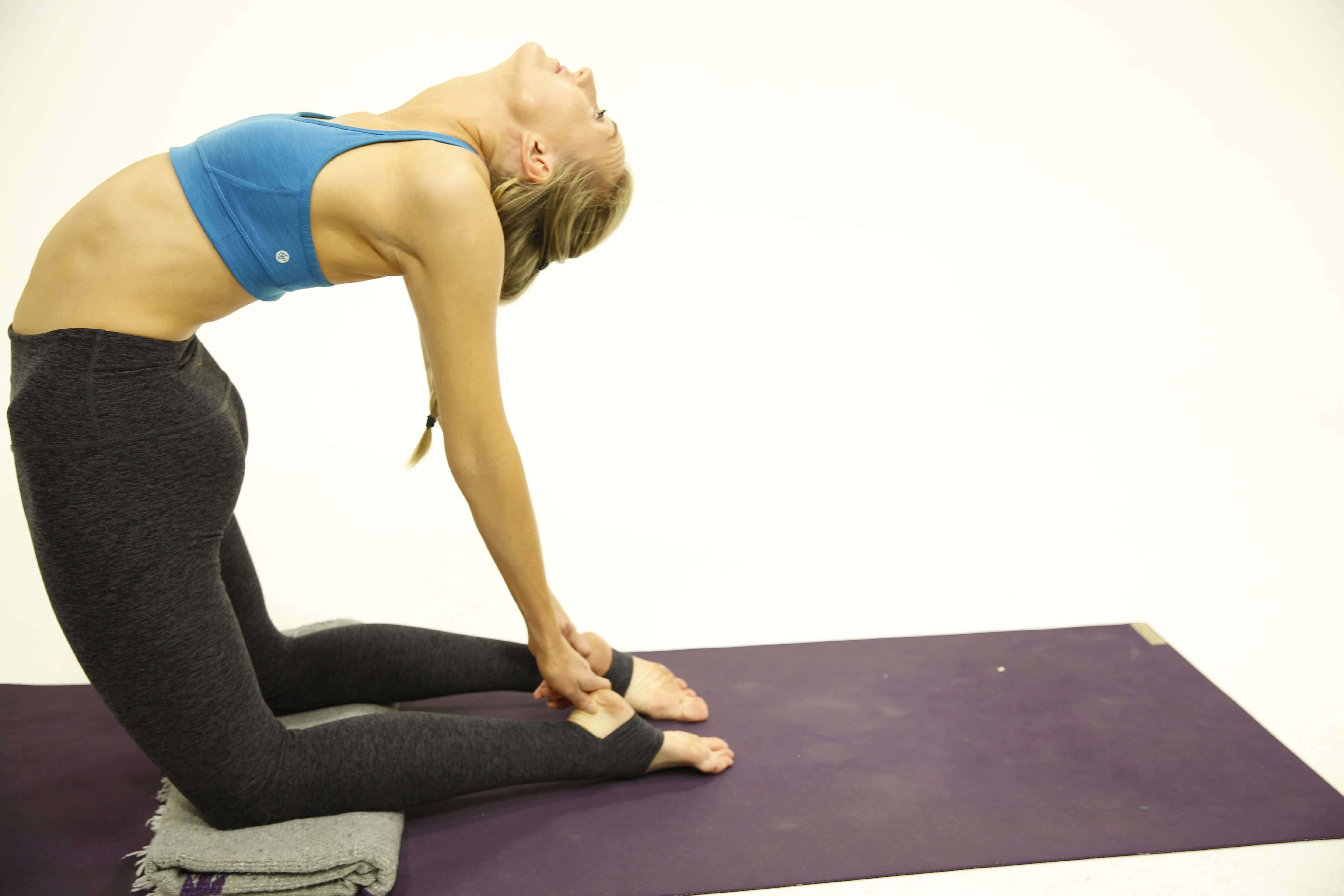
Camel Pose is a deep heart opener that will release all blockages in your Heart Chakra. It also stretches the entire front body, including your chest, hip flexors and throat as well as your thighs and ankles.
At the same time, it strengthens the back muscles and helps to improve bad posture.
How to do the Camel Pose:
- Kneel, but keep your hips elevated instead of sitting back on the feet.
- Make sure your knees, hips and shoulders are stacked. If you’re not sure, make sure that your right knee is directly below the right hip and that your left knee is directly below your left hip. Keep your spine erect.
- Bring your hands to the lower back with your fingertips pointing downward and your palms pressed into your back.
- Push your hips and upper body forward and simultaneously lift your heart toward the sky
- As you’re leaning back, you have an option to relax your neck and to grab your heels with your palms. If this is uncomfortable to you, keep your chin tucked so that your neck is in line with your spine. You can also reach your left arm back and grab your left foot while keeping your right arm and hand placed on your lower back.
Hold the Camel pose for up to three breaths and with a slow and controlled motion transition into Child’s Pose to rest. Repeat several times.
5. Solar Plexus Chakra – Bow Pose
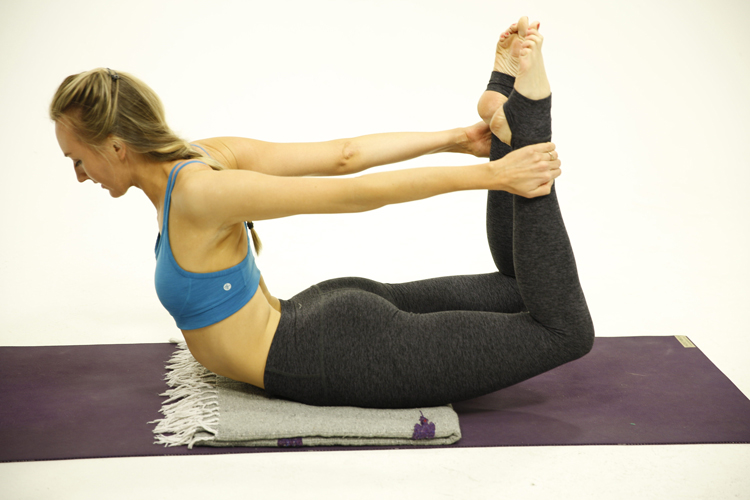
Although the Bow Pose works the entire body, it is particularly connected to the area around the Solar Plexus Chakra (behind the abdominal muscles). It’s believed that the pose can release the chakra and help us let go of all worries and insecurities.
Bow pose increases the blood flow into the abdomen and stimulates the digestive system. It also strengthens the whole back and provides a deep stretch to the front torso, shoulders and thighs. It is a tremendous yoga asana for the upper body.
How to do the Bow Pose:
- Lie on your stomach with arms lying flat beside you and palms facing upwards
- Bend your knees and try to get the feet closer to the glutes
- Grasp your ankles or shins with your hands
- As you inhale, simultaneously lift your chest and thighs up
- Ensure that your knees stay hip-width apart and breath deeply
Hold the pose for up to one minute and slowly release. Make sure you are always warmed up before doing Bow. It would be best to add it to the end of your practice so that your muscles are warm. If you can’t keep your knees parallel, consider working on increasing flexibility in your hips.
6. Root Chakra – Easy Pose
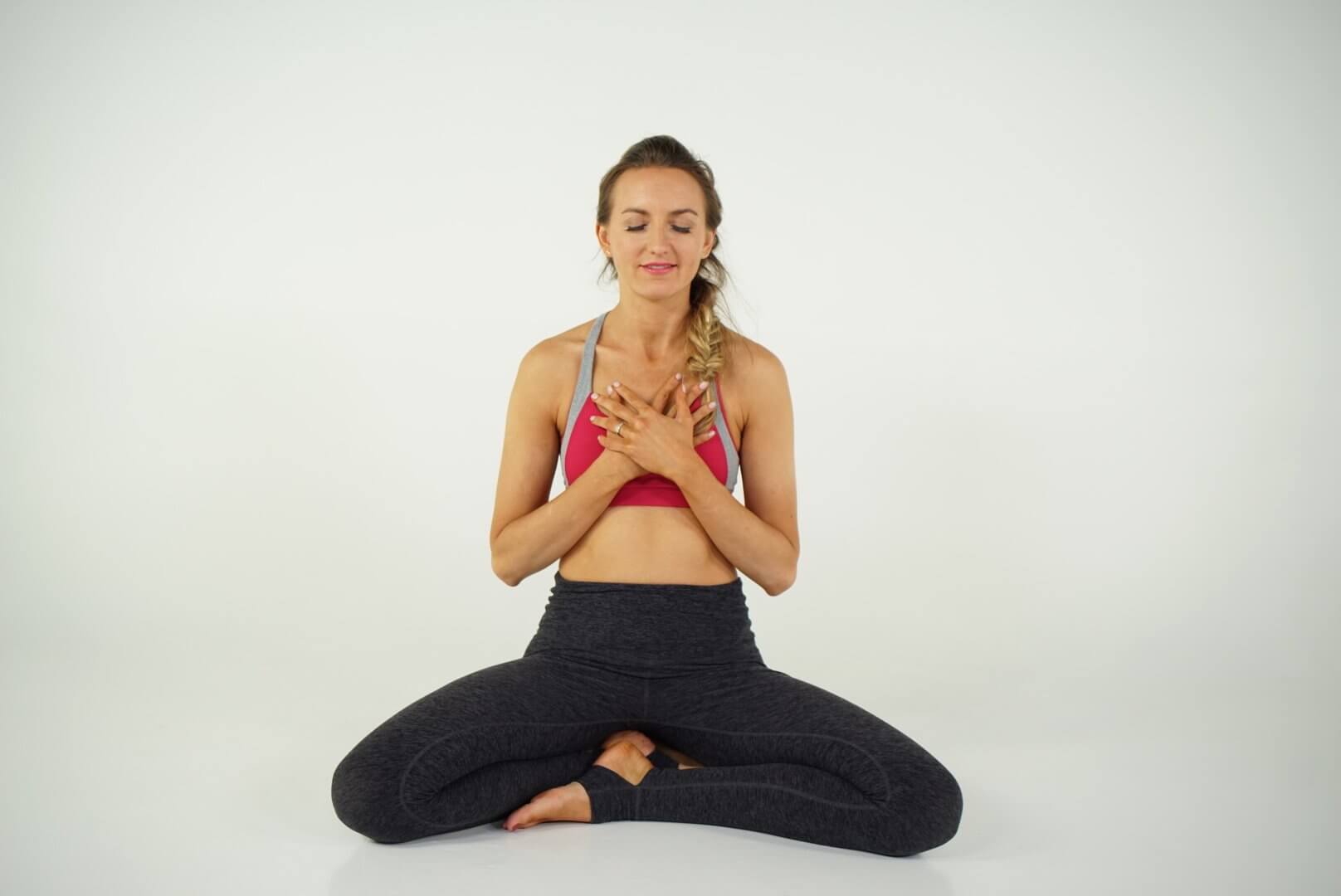
Easy Pose is simple but is one of the best seated yoga poses to balance the Root Chakra. As your pelvis is connected to the floor, it invokes a sense of stability, grounding and connection to the earth. This asana is often used for meditation and the long holds can help lengthen aching knees and ankles.
How to do the Easy Pose:
- Sit on your mat or a cushion if you can’t keep your spine straight
- Bend your knees and cross your feet
- The feet can be right in front of you or tucked beneath your knees for a deeper stretch
- Tilt your pelvis forward to keep your spine long
You can hold this pose as long as it is comfortable for you. It is a great way to complete your practice as it grounds you down. You can set an intention to free blockages from the root chakra, repeat a mantra, or do any other meditation technique that helps you to feel secure and at peace.
Final Thoughts
You can certainly find other seated yoga postures to help with specific ailments. A seated spinal twist, for example, is a powerful posture that increases flexibility of the spine.
After all, it is your personal yoga practice and you can use it how you would like.
But if you want to practice each seated posture in support of the chakras, then this is a great flow to get you started.
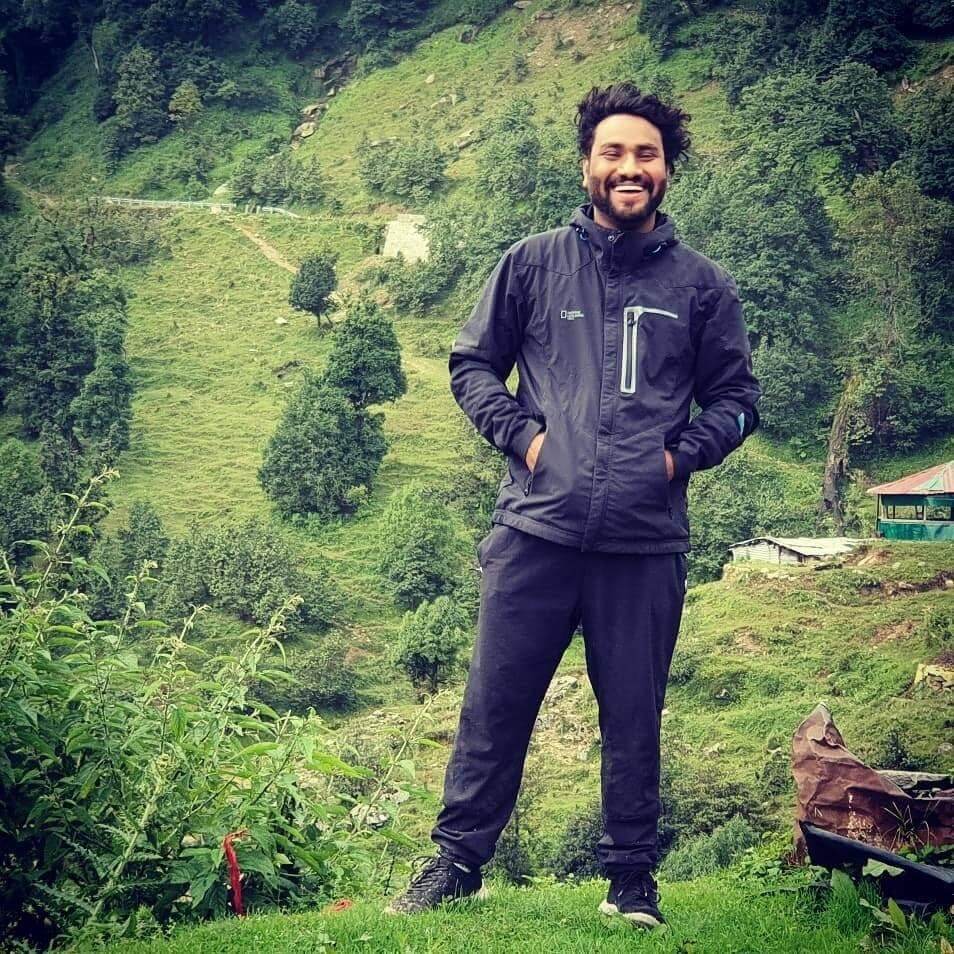
Mayank Rana
Drishti Yoga School
Mayank Rana is an E-RYT 200 Certified Yogi Travel Nomad from the divine city of Rishikesh who loves to explore the Mountains and writes about them. He is the founder at Drishti Yoga School. The yoga school is based in Rishikesh and provides 200 Hour Yoga Teacher Training in Rishikesh.
Experience 3 Training Videos from Inside My 200-Hour Online YTT

YOU MIGHT ALSO LIKE
- What is Kriya Yoga? The Philosophy and Practice
- Uddiyana Bandha: Tapping Into Your Deep Core
- 4 Reasons Hasta Bandha Is Essential To Your Yoga Practice
- Vitarka Mudra: What It Is and How Do You Use It?
- Shakti Mudra: What It Is and How Do You Do It?
- Garuda Mudra: What It Is and How Do You Use It?
- Kali Mudra: What It Is and How Do You Do It?
- Shunya Mudra: What It Is and How Do You Do It?
- Varuna Mudra: What It Is and How Do You Use It?
- Vayu Mudra: What It Is and How Do You Use It?
- Samana Vayu: The Energy of Balance & How to Access It
- Apana Vayu: The Energy of Release & Surrender
- Udana Vayu: The Ascending Wind
- Prana Vayu: The Breath of Vitality
- Vyana Vayu: The Energetic Secret to Flow
Learn how to do 11 of the most popular yoga poses correctly. Free video + PDF download.










